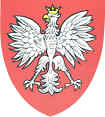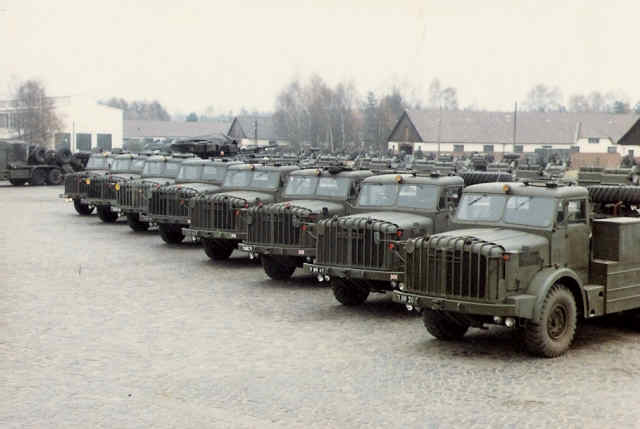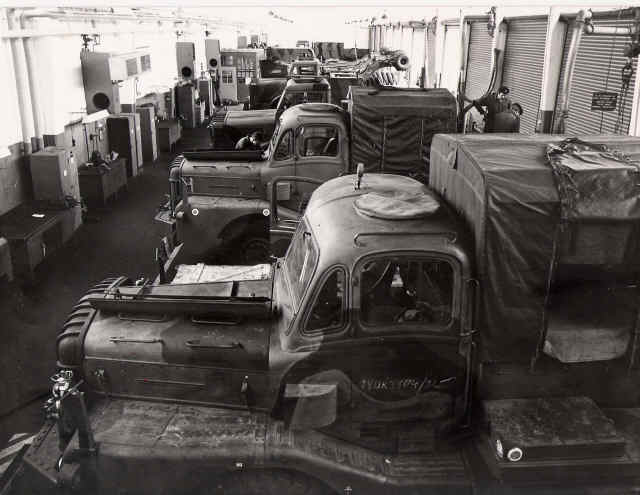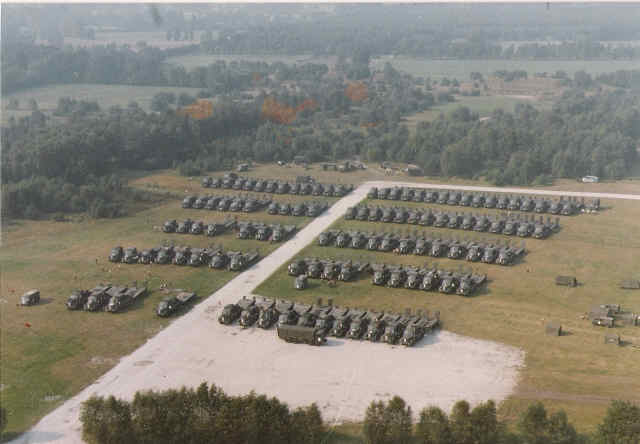

A very full open cobbled area just prior to a ‘drag’ or ‘lift’ (colloquial terms for a tank
movement detail). Open sided vehicle park buildings in right background. View is towards the west and the internal gate with the adjacent cavalry barracks. This picture was taken just prior to 1979, as the trailers in the extreme right centre were ‘back loaded’ as redundant by me in that year.
.jpg)
The Trailer Park showing the 25 metre range at left background, open sided vehicle hangers to the right and one of every vehicle type of 16 Tank Transporter Squadron RCT in 1979 in the foreground.
From left to right: Land Rover convoy lead escort vehicle; REME ‘drag’ van for roadside repairs; Bedford RL REME spares and mobile accn; Foden 16 ton for the carriage of light ‘A’ vehicles; Mk II petrol Antar tractor for towing semi trailer; Mk III diesel Antar tractor with ballast body; Mk III diesel Antar tractor for towing semi trailer; Scammell 20 ton tractor with semi trailer for carriage of light ‘A’ vehicles; AEC Militant 10 ton cargo truck as tyre exchange vehicle; Bedford MK 4 ton cargo truck as cooks vehicle; Convoy escort motor cycle.
I was OC of the tank transporter unit from 1978 to 81 (16 Tk Tptr Sqn RCT) The history of ‘Tank Transporting’ in Fallingbostel is as follows. Tank transporters first came to St. Barbara Barracks in June 1952 and they are still based there today! They have always been operated by the RASC, who in 1965 changed their name to the RCT and again in 1993 to the RLC. The first unit was manned by Poles of the MSO (Mixed Service Organisation), with RASC officers and some SNCOs. They were equipped with Diamond ‘T’ US made tank transporters. The Poles were mainly ex German POWs, either captured early in the war, or whilst they were serving with the Allied Forces. As Poland came under Eastern Bloc control after WWII these men chose to stay in the West and work for the British. On reaching retirement age the West German government was obligated to give them a pension and a retirement home.
.jpg)
Sqn HQ building for 16 Tank Transporter squadron RCT (basically a converted
accommodation block. An MSO (Mixed Service Service) Superintendent (officer) is being driven out on retirement. The vehicle is a MkllI Mighty Antar tank transporter.
In 1965 the unit was re-titled 15 Tk Tptr Sqn RCT and was equipped with the Thorneycroft Mighty Antar tank Transporter. By 1979 there were two troops of Poles and two of British soldiers. The unit could ‘lift’ 60 tanks and 20 light ‘A’ vehicles at the same time. One Pole tank transporter driver showed me a photo of him as a thin teenager holding a broom, standing in St. Barbara Barracks in 1944, where he was then a POW ‘working’ for the Germans. His role – to sweep up broken glass and debris after the American P47 Thunderbolts, returning from escorting the US daylight raids to Berlin, had ‘cannoned’ the barracks, as an ‘opportunity target’ whilst returning to the UK. He had lived in St. Barbara’s ever since! Of course all had left their families behind in Poland, though by the 1970’s they were allowed infrequent trips back into Soviet controlled Poland to meet with relatives. By the late 1980’s all the Poles of the MSO had retired and so 16 Sqn was fully UK manned, driving the Scammell Commander Tk Tptr and deploying to the first Gulf war. In 1993 they finally became 16 Tk Tptr Sqn RLC, where they still reside in St. Barbara’s, an ideal location to haul tanks to and from the Hohne training area. How many other units of BAOR have been in the same location continuously for 56 years?

The tank transporter trade badge which is worn on the working dress by all class 1 tank transporters above the left hand breast pocket. It was removed in a uniform review around the 2002 period, with it being reinstated in 2006 much to the relief of those whose job it is to tansport the heavy armour around the battlefield.
Formerly known as 312 Unit MSO RASC the Squadron belonged to 7 Tank Tranporter Regiment RCT, based at Sennelager, but otherwise an autonomous unit, commanded by the local Armoured Bde HQ in the Soltau/Fallingbostel/Hohne area. Known today as 7 Transport Regiment RLC, the Regiment is based at Bielefeld with 16 Sqn remaining in Fallingbostel. The HQ Sqn takes its name from 617 Tank Transporter Squadron who also formed part of this regiment and were based in Hamm.
St. Barbara’s Barracks, Fallingbostel.
All taken photos taken between 1979-81
Basically the barracks were still (in the 1970s/1980s) exactly how the Germans had built them in 1937/38 as temporary transit accommodation for units using the newly opened Hohne Training Area. I was told that this ‘live fire’ training area was in constant use except for the two hottest summer months; these two ‘stand down’ months came about because the horse flies bred in such profusion then that they drove the army horses mad and that nothing could mitigate the flies bites!
St. Barbara’s Barracks seemed to be an artillery designated compound due to its extensive stabling and covered (but open sided) limber/trailer/gun parking areas
.jpg)
General view of the Trailer Park, the REME Workshop is the white 3 windowed building in the
distance. To its immediate RH side is the sole entry and exit route for tank transporters, that accessed directly onto the Hohne range complex ‘ring road’. This in turn had direct access to the nearby autobahn. Note the original cobble stones of the trailer park. Left Side background is of the open sided, but roofed, storage areas, used for tank transporter tractor parking

Another view of the cobbled open standing, REME Workshops and stable Blocks (3 shown)
.jpg)
An end view of one of the open sided vehicle park buildings
.jpg)
Another of the open sided vehicle buildings, but this has been post war modified to incorporate roller doors for the sides and roof lights to compensate for the resulting darkness!. The tank is a Churchill hulk used for winch training. It now resides at a museum somewhere in the UK
.jpg)
Cobbled open parking area looking south. In central background is one of the WWII horse
stables, now used as an equipment store, but still containing metal wall mounted feed boxes together with interior and exterior wall mounted metal ring bolts for tethering animals. I believe that these buildings now have some form of ‘designated historical’ status placed on them by today’s German Government.. There were three or four (possibly more) such stable blocks and, from memory, I think each could accommodate at least 100 horses
.jpg)
Close up of the open sided vehicle park buildings, there were at least four such buildings, each at the north side of the cobbled trailer park

The Workshops in 1979

Inside the REME Workshops. a post WWII building?

Mandalay range complex. 1980 – over 100 British tank transporters await the start of Exercise Spearpoint 80 (16 & 617 Tank Transporter Squadrons RCT). A further 40 are still in their unit lines a few miles away (3 Tank Transporter Squadron RCT)
All photos courtesy of R F Grevatte-Ball
